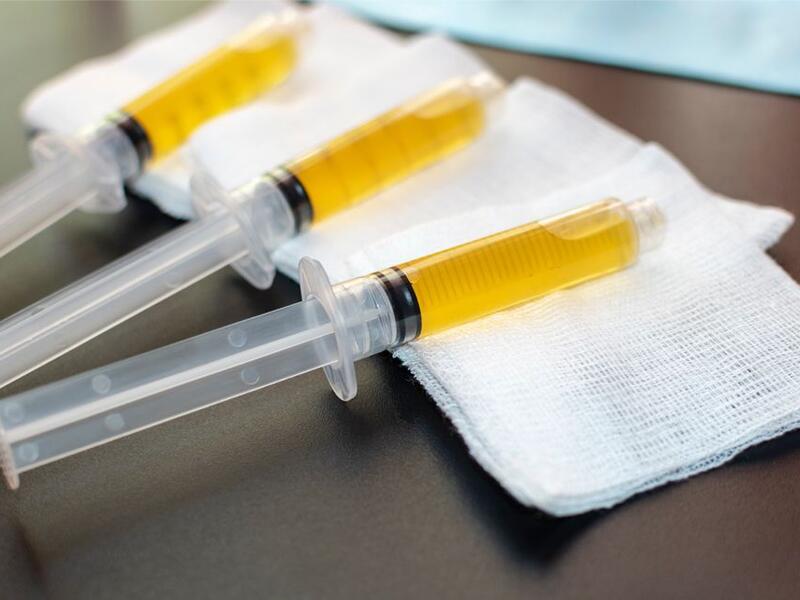PRP Facelift
PRP Treatment: What Is a PRP Facelift?
A PRP Facelift is also known as a Vampire Facelift because the main ingredient is your own blood. It uses the growth factors in your blood to rejuvenate and heal your skin while combating the signs of aging and resolving problematic skin conditions. The entire treatment is non-surgical, but it’s often referred to as a facelift because of the dramatic results that come from both the PRP treatment and the dermal fillers used during the treatment.
Patients love this treatment for its ability to treat different skin issues and the dramatic results that come after just one facial. This treatment is so popular because of its many benefits. It can:
- Reduce your pore size, making them smaller and tighter
- Create new collagen
- Smooth out the surface of your skin
- Reduce the appearance of blemishes and age spots
- Decrease your total number of fine lines and wrinkles
- Improve the tone of your skin and even out your skin color
- Smooth out the surface of your skin
How Does It Work?
The PRP Facelift combines the application of platelet-rich plasma with hyaluronic acid-based dermal fillers. To begin the treatment, dermal fillers are injected into different areas of your face that need more volume.
The Injections
The aging process leads to volume loss, but thanks to dermal fillers, there is a way to temporarily restore that volume and in doing so, restore youth. The dermal fillers used during this treatment can correct wrinkles, facial folds, and hollow areas. They can restore volume to many areas, including:
- Areas around the mouth
- Moderate to severe nasolabial folds
- Cheeks
Once administered, these injectables will give you immediately noticeable results. They will enhance the shape of your face and provide you with a natural, subtle look. Your face will appear smoother and more youthful and you’ll still look like you, just a better version of you.
The PRP Treatment Process
A topical numbing agent is used on the face. Once we administer the dermal fillers, we’ll then begin the PRP treatment. This treatment begins with a blood draw. Your blood will then be placed into a sterilized centrifuge, which is a device that will spin the blood rapidly for a set period to separate the plasma from the PRP. Once isolated, we’ll apply the platelet-rich plasma to the surface of your skin. Different techniques can administer the PRP to the skin including microneedling and injections.

Your PRP Delivery
We’ll determine the best administration method based on your age, your skin, and your goals. If we determine microneedling is the best method, we’ll apply the PRP to your skin and use a device covered in thin needles to create tiny injuries on the surface of your skin. The PRP will sink into these channels which the body interprets as tiny injuries, and begin its transformative process.
If we determine that PRP injections are the best method of delivery, we’ll carefully inject your PRP back into your face with an ultra-fine needle. You won’t have to worry about any pain because we’ll apply a topical numbing cream to your skin pre-injection to keep you as comfortable as possible.
What Are the Benefits of PRP?
There are many different benefits associated with PRP treatments. The platelet-rich plasma helps heal your skin, restores vitality and youth, and can resolve several different problematic skin conditions that stem from the aging process. It can cause:
- Proliferation and differentiation of the cells
- Extracellular matrix (ECM) accumulation
- Increased production of collagen and elastin
How Do I Prepare for My Treatment?
There are some treatments and activities that you should avoid before your treatment to ensure the best results. We may ask you to:
- Temporarily stop using anti-inflammatory medications (Motrin, Ibuprofen)
- Avoid excessive heat
- Temporarily stop using certain topical products (salicylic acid, glycolic acid, and other anti-aging ingredients)
- Avoid excess sun exposure
- Avoid waxing, bleaching, or tweezing
When you arrive at your appointment, come with a clean face free of makeup or products. After your treatment, use plenty of moisturizer to hydrate your skin, drink a lot of water, avoid picking or scratching your skin, and avoid the sun and intense exercise for at least 24 hours post-treatment.
Is There Any Downtime?
We recommend resting the day of the procedure. The entire treatment will take approximately 90-120 minutes to complete. You may have redness, bruising and possibly peeling for 3-5 days after the procedure.
